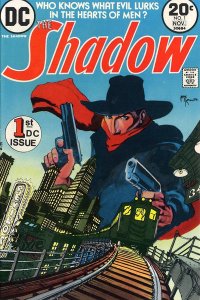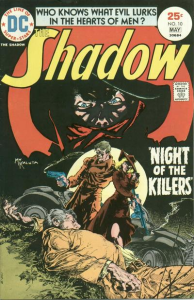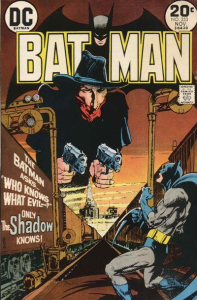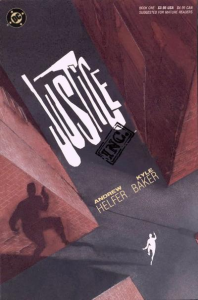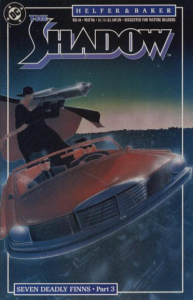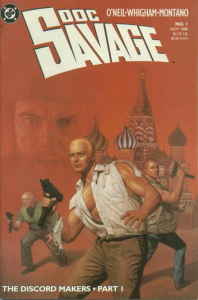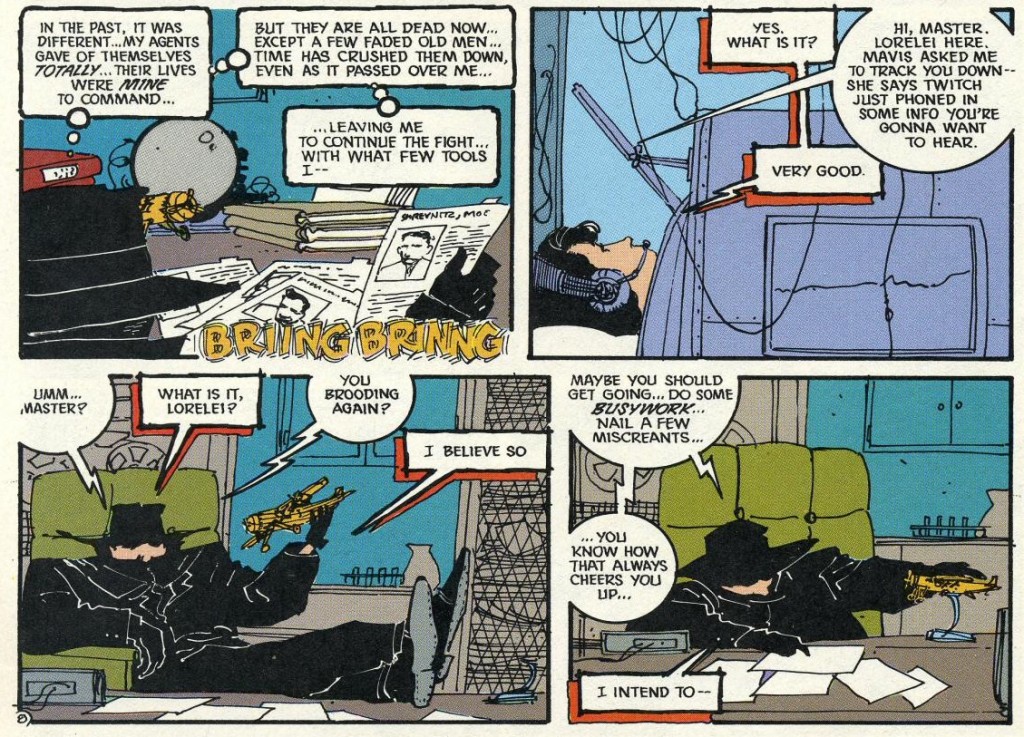Every once in a while, I like to shift gears and spotlight comics or films set outside Gotham City that Batman fans should nevertheless enjoy because they are close to the mood of the world of the Dark Knight. Once a year, I take this one step further and devote a whole month to comics about vigilantes who don’t dress as bats yet also kick plenty of ass!
Despite some overlap with superhero stories, vigilante fiction is its own little beast, rooted in specific fictional rules, political ideals, and a viscerally satisfying (yet highly problematic) appeal. With this in mind, this year I want to take a look at what happens when this brutish subgenre is taken up by some of the quirkiest comic book authors out there…
Let’s get things started with DC’s deranged revamp of The Shadow in the ‘80s.
Created by Walter B. Gibson in 1930, the Shadow is a remorseless vigilante who wages war on criminals with all guns blazing (literally), assisted by hypnotic abilities as well as a network of agents working for him. Besides being a huge influence on the original conception of Batman, this character has left a direct mark on pop culture, with his stylish look, his ominous laugh, and signature lines such as ‘Who knows what evil lurks in the hearts of men?’ or ‘The weed of crime bears bitter fruit. Crime does not pay… The Shadow knows!’
In the 1970s, Denny O’Neil wrote a Shadow comic series, breathtakingly illustrated by Mike Kaluta, Frank Robbins, and E.R. Cruz. O’Neil also worked the Shadow into the DC Universe by having him cross paths with the Caped Crusader in a couple of Batman issues… These were spiffing adventure yarns whose tone was unabashedly pulpy (with a dash of noir), paying homage to the feel of the character’s earlier prose and radio tales.
A decade later, DC took a risk and let Howard Chaykin loose on the property, resulting in an unforgettable 1986 mini-series, later collected as Blood & Judgment. The 35-year-old Chaykin had just reached a career high point with the cyberpunk critical darling American Flagg! and seemed determined continue blowing the minds of anyone who dared read his stuff. As he explained to The Comics Journal at the time, Chaykin was not a big fan of the political and moral attitudes associated with the Shadow, so he set out to reinterpret the character through tongue-in-cheek myth-debunking, taking advantage of DC’s carte blanche to go wild.
It should therefore come as no surprise that Blood & Judgment was fairly controversial. When it debuted, the series was DC’s biggest hit (next to The Dark Knight Returns), but it drew a lot of flak for its violence, sex, and iconoclastic approach to the franchise. Howard Chaykin radically revised the Shadow’s origin and established that, even though he had been around since the pre-WWII era, by the eighties this sardonic vigilante still looked as young as ever as he viciously fought crime with a pair of Uzi submachine guns (instead of the usual pistols).
And just to make sure he pissed off as many fans as possible right off the bat, Chaykin devoted most of the first issue to killing off the Shadow’s former agents, dispatching beloved characters in gruesome ways:
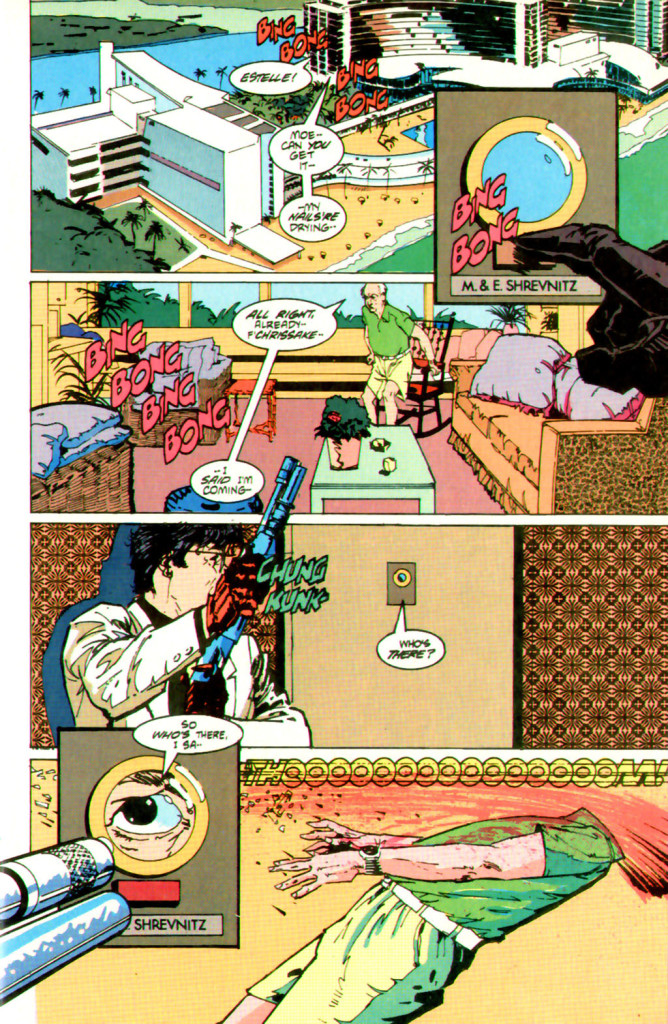 The Shadow (v2) #1
The Shadow (v2) #1
Howard Chaykin’s free-for-all iteration of the Shadow made no apologies for his bloodthirstiness or male chauvinism. This was not a retcon as much as a logical extrapolation: after all, although he had preserved his youth, in the story the Shadow was still a product of the early 20th century… That, plus the fact that he had been isolated from the world (in the mystical scientific utopia of Shambala) since 1949, meant that he had hardly kept up with the times, including the latest views on heroic justice and sexism.
In fact, one of the themes running through the mini-series – indeed, through many Chaykin comics – was precisely the contrast between old values and modern times…
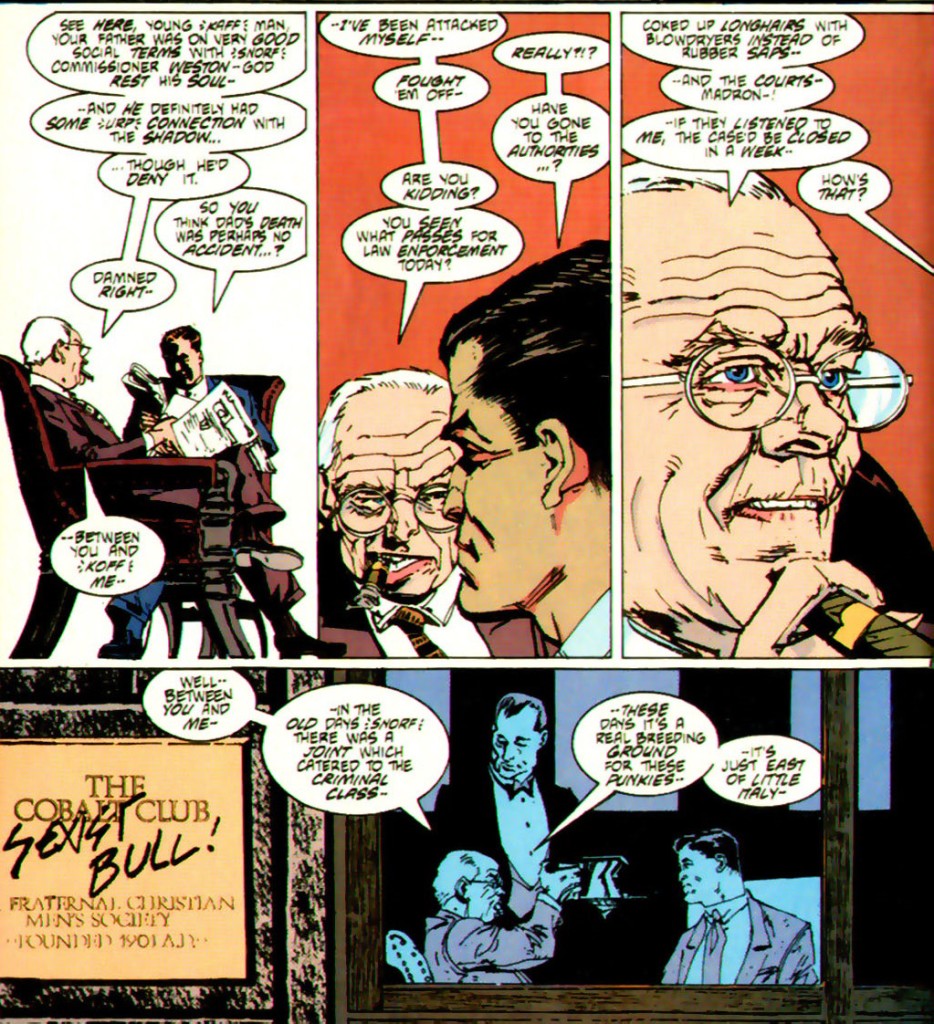 The Shadow (v2) #3
The Shadow (v2) #3
So yes, Blood & Judment is a very Chaykin kind of comic, for better or worse. There is incredibly convoluted plotting, with the megalomaniac villain carrying out an elaborate plan that at one point involves threatening to nuke New York City as part of a quest to achieve eternal youth. The series has loads of characters and plenty of stuff taking place at the same time, creating a deliberately disorienting reading experience. With its sharp visuals and dazzling compositions, however, it does look terrific (although Chaykin definitely has to share credit for this with colorist Alex Wald). And, needless to say, the whole thing is gleefully raunchy… Hell, one of the subplots concerns the old, wheelchair-bound villain’s habit of having sex with a lunatic trophy wife via his laboratory-created congenital idiot son, whose body he controls via telekinesis!
While Howard Chaykin moved on to his next project (a similarly provocative revamp of Blackhawk), the editor of Blood & Judgment, Andrew Helfer, took the comic’s concepts and churned out an ongoing series set in the same over-the-top reality. Now edited by Mike Carlin, the series was written by Helfer and, at first, illustrated by Bill Sienkwiewicz, who delivered the kind of eccentric art such a comic deserved…
 The Shadow (v3) #1
The Shadow (v3) #1
Andy Helfer threw everything at the reader, kitchen sink and all. The first arc, ‘Shadows and Light,’ included at least four interlinked major villains, each with a different evil agenda, ranging from personal revenge against the Shadow to an attempt to prevent the return of Taiwan to communist China. Sure, it was a confusing mess – the pages were wordy and cluttered, the plots were overcrowded, meandering, and not always easy to follow… Still, I have a soft spot for this type of surrealist chaos!
Besides sticking to Blood & Judgment’s darkly comedic spirit, Helfer brought back Chaykin’s creations such as Lamont Cranston’s half-witted clone, the Shadow’s super-powered sons Hsu-Tei and Ching Yao Chang (with their nifty flying car), and the manager of his new network of operatives, Lorelei (who was connected to an iron lung and assisted by trained monkeys). Best of all, Helfer continued to develop the mini-series’ depiction of Inspector Joe Cardona as an uproariously cranky, hard-bitten old cop.
The large and often grotesque supporting cast was more fascinating than the titular hero, whom Andrew Helfer never bothered to make all that relatable or even likable… One of the subversive running gags was precisely the fact that the Shadow ran his network of agents like a despotic boss who just happened to be in the business of slaughtering criminals. And as if that wasn’t mean enough, the Shadow died in the second half of the series and spent the last handful of issues as an increasingly mutilated corpse.
What’s more, starting in issue #8, Kyle Baker became the regular artist. This was a smart move: Baker is one of the funniest comic creators out there, both as an artist and as a writer (for example, he did the hilarious You Are Here and The Cowboy Wally Show, not to mention his masterpiece Why I Hate Saturn). As The Shadow’s own credits put it, Baker brought ‘a healthy dose of perverse enthusiasm’ to the project.
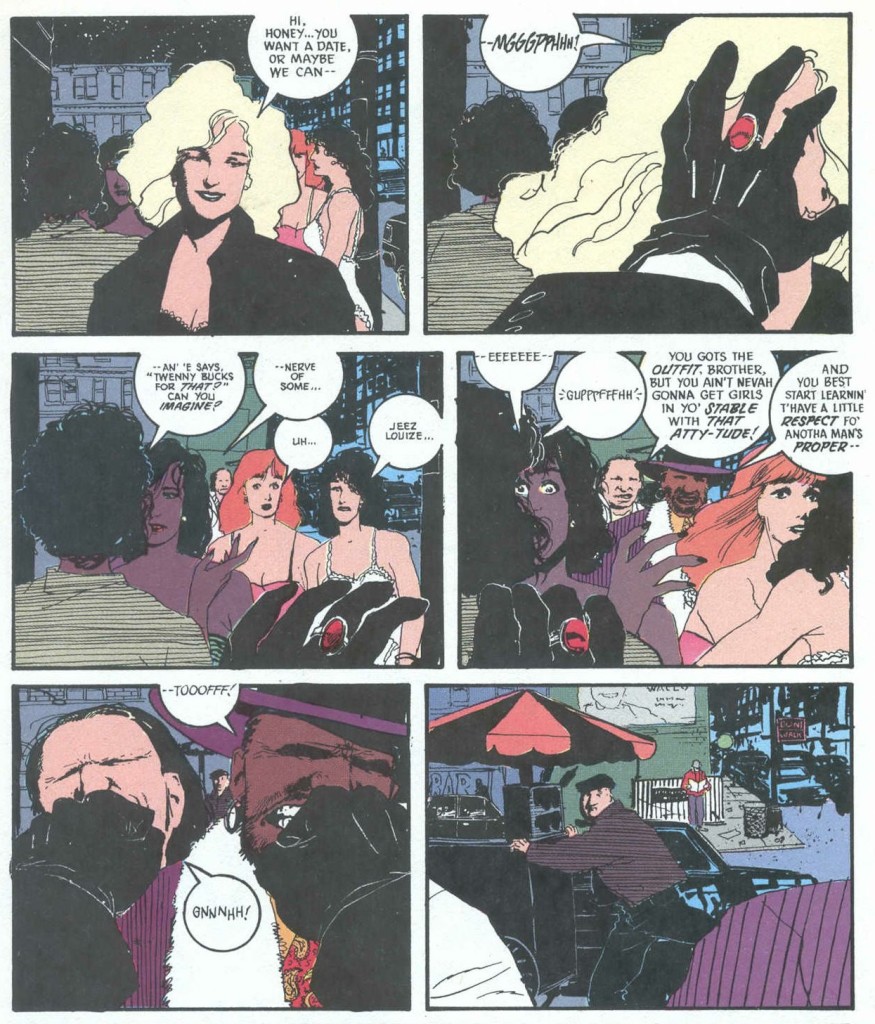 The Shadow (v3) #8
The Shadow (v3) #8
To be fair, the series did lose some steam after a while, although it picked up momentum again towards the end. More than the flaws, however, it’s the high points that stick in my mind…
I’m particularly fond of ‘Fragment of the Sun,’ the prologue to the first arc, which was published in The Shadow Annual #1, with pencils by Joe Orlando. Set in the late ‘40s, this issue has a lot of fun with the paranoia of the early atomic era, as the Shadow and his crew go up against a religious cult of nuclear power that tries to subliminally spread its gospel through television. The second annual is quite strong as well – it’s an amusing pastiche of Citizen Kane, dedicated to Orson Welles (who voiced the Shadow in the 1937 radio show).
Also cult-worthy, ‘Harold Goes to Washington’ (issue #7), drawn by the wonderful Marshall Rogers, tells the twisted story of a schoolkid who wants so badly to become a war hero that he is willing to assassinate Ronald Reagan just because the president promised to usher in world peace. And in ‘A Town Called Malice’ (issue #15), the Shadow’s bumbling sons stumble into a town on the outskirts of China that serves as a haven for all sorts of criminals yet has its own peculiar brand of justice:
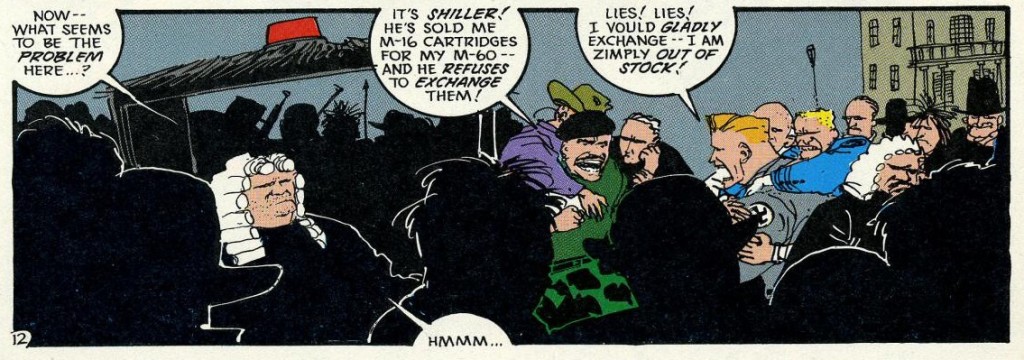
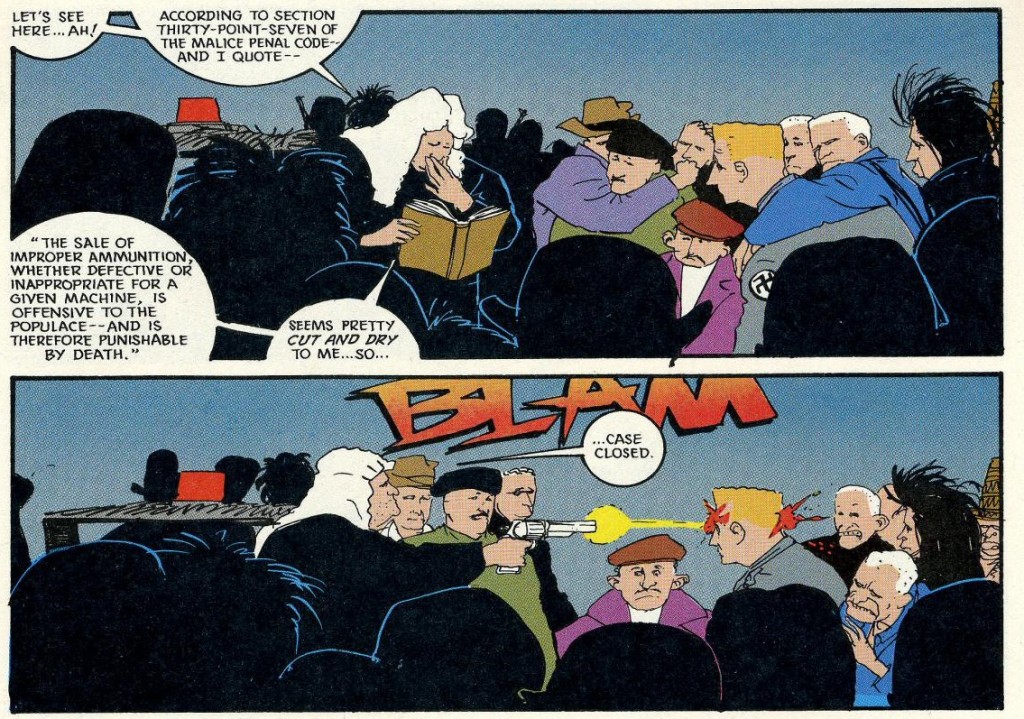 The Shadow (v3) #15
The Shadow (v3) #15
Andy Helfer and Kyle Baker went on to do the underappreciated mini-series Justice, Inc., where they gave the same cartoonish treatment to another classic pulp hero: in this mini, the Avenger (a master of disguise who had also shown up in a couple of issues of The Shadow) starts working for the US secret services, impersonating and toppling third world leaders, and ends up trying to shift the whole paradigm of Cold War politics. It’s a poignant, gonzo satire (even though it’s final punchline doesn’t go as far as the similar Elektra: Assassin) that remains criminally uncollected.
Between Justice, Inc., The Shadow, and Denny O’Neil’s revamp of Doc Savage (which also brought the titular character into the eighties), this was a fun era in which DC seemed willing to let creators drastically tear apart and rebuild old properties, nostalgia be damned.
Almost thirty years after his first take on the Shadow, Howard Chaykin returned to the character with the mini-series Midnight in Moscow, an international adventure set in 1949. Clearly a product of an older, melancholic author, this is a more uninspired, clichéd tale that lacks the manic energy of Blood & Judgment, even if it does feature a number of beautiful passages.
Meanwhile, the kind folks at Dynamite Entertainment have collected the two Chaykin minis as well as Helfer’s run, labeled The Shadow Master Series (although sadly without the annuals). So if you ever tire of portentous stories about whiny and brooding heroes, you can now easily get your hands on a crime comic that, refreshingly, doesn’t take its protagonist all that seriously…


